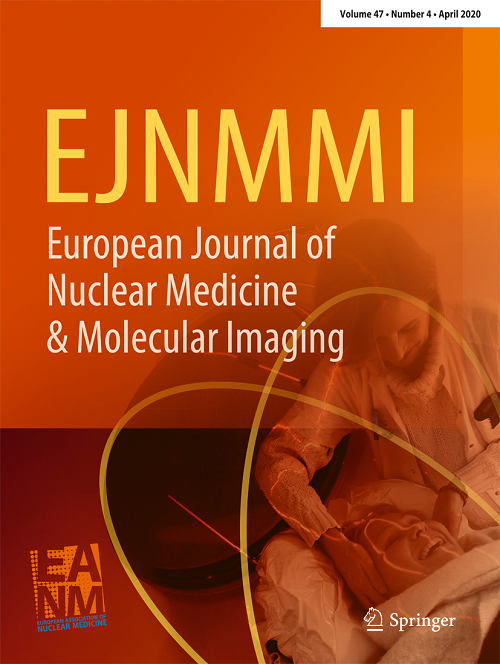Clinical evaluation of dynamic [18F]FDG PET imaging to distinguish infection from inflammation in fracture-related infections.
IF 7.6
1区 医学
Q1 RADIOLOGY, NUCLEAR MEDICINE & MEDICAL IMAGING
European Journal of Nuclear Medicine and Molecular Imaging
Pub Date : 2025-09-20
DOI:10.1007/s00259-025-07563-x
引用次数: 0
Abstract
BACKGROUND Standard [18F]FDG PET/CT is widely used to detect infections, but is limited in differentiating bacterial infection from inflammation due to overlapping uptake patterns. This distinction is particularly challenging in fracture-related infection (FRI), due to multiple factors, including recent surgery, soft tissue injury, fracture healing, and surgical implants. Dynamic [18F]FDG imaging over time may overcome this limitation by capturing a rapid, sustained uptake seen in infections, driven by ongoing immune and microbial activity, as opposed to the potentially slower uptake in inflammation. This study investigates the potential of dynamic [18F]FDG PET/CT using time-activity curves (TACs) to distinguish infection from inflammation in patients with suspected FRI. METHODS A prospective study was performed in patients referred for [18F]FDG PET/CT examination to detect (the extent of) FRI from December 2021 until November 2024. Final clinical diagnosis of FRI was established according to the criteria defined by the FRI consensus group and used as a reference standard. Dynamic PET imaging was performed using a long axial field-of-view PET/CT system over a 65-minute period after [18F]FDG injection. TACs were analyzed to compare uptake patterns between confirmed infections and inflammation, and diagnostic accuracy was calculated and compared to conventional standard imaging. RESULTS Thirty-one patients with 33 fractures suspected of infection were included. Infection was clinically confirmed in 14 fractures (42%). Diagnosis of FRI based on dynamic imaging using TACs resulted in a high sensitivity of 86%, specificity of 100%, PPV of 100% and NPV of 90%, resulting in a diagnostic accuracy of 94%. In the infection group, Fracture SUVpeak increased progressively over time, while in the inflammation group, uptake appeared to reach a plateau (p < 0.001). Visual interpretation of the dynamic imaging yielded a diagnostic accuracy of 82%. For standard imaging, quantitative and visual assessments showed diagnostic accuracies of 91% and 88%, respectively. CONCLUSION This proof-of-concept study demonstrates that dynamic [18F]FDG PET/CT using TACs can distinguish infection from inflammation in patients with suspected FRI, with high diagnostic accuracy observed, and suggesting a potential advantage over standard imaging. Larger-scale studies are needed to validate these results and explore the full clinical potential of dynamic imaging in infection management.动态[18F]FDG PET成像在骨折相关感染中区分感染与炎症的临床评价
[18F]FDG PET/CT广泛用于检测感染,但由于摄取模式重叠,在区分细菌感染和炎症方面受到限制。由于多种因素,包括近期手术、软组织损伤、骨折愈合和手术植入物,这种区分在骨折相关感染(FRI)中尤其具有挑战性。随着时间的推移,动态[18F]FDG成像可以克服这一限制,因为它可以捕捉到感染中由持续的免疫和微生物活动驱动的快速、持续的摄取,而不是炎症中潜在的较慢的摄取。本研究探讨了动态[18F]FDG PET/CT使用时间-活性曲线(TACs)区分疑似FRI患者感染和炎症的潜力。方法在2021年12月至2024年11月期间,对转诊进行[18F]FDG PET/CT检查以检测FRI(程度)的患者进行前瞻性研究。FRI的最终临床诊断依据FRI共识组确定的标准,并作为参考标准。[18F]FDG注射后65分钟内,使用长轴视野PET/CT系统进行动态PET成像。分析tac以比较确诊感染和炎症之间的摄取模式,计算诊断准确性并与常规标准成像进行比较。结果共纳入33例疑似感染骨折31例。14例骨折(42%)临床证实感染。基于TACs动态成像诊断FRI的灵敏度为86%,特异性为100%,PPV为100%,NPV为90%,诊断准确率为94%。在感染组中,骨折SUVpeak随时间逐渐增加,而在炎症组中,摄取似乎达到平台(p < 0.001)。动态影像的视觉解释诊断准确率为82%。对于标准影像学,定量和视觉评估的诊断准确率分别为91%和88%。结论:这项概念验证研究表明,使用tac的动态[18F]FDG PET/CT可以区分疑似FRI患者的感染和炎症,诊断准确率很高,与标准成像相比具有潜在优势。需要更大规模的研究来验证这些结果,并探索动态成像在感染管理中的全部临床潜力。
本文章由计算机程序翻译,如有差异,请以英文原文为准。
求助全文
约1分钟内获得全文
求助全文
来源期刊
CiteScore
15.60
自引率
9.90%
发文量
392
审稿时长
3 months
期刊介绍:
The European Journal of Nuclear Medicine and Molecular Imaging serves as a platform for the exchange of clinical and scientific information within nuclear medicine and related professions. It welcomes international submissions from professionals involved in the functional, metabolic, and molecular investigation of diseases. The journal's coverage spans physics, dosimetry, radiation biology, radiochemistry, and pharmacy, providing high-quality peer review by experts in the field. Known for highly cited and downloaded articles, it ensures global visibility for research work and is part of the EJNMMI journal family.

 求助内容:
求助内容: 应助结果提醒方式:
应助结果提醒方式:


